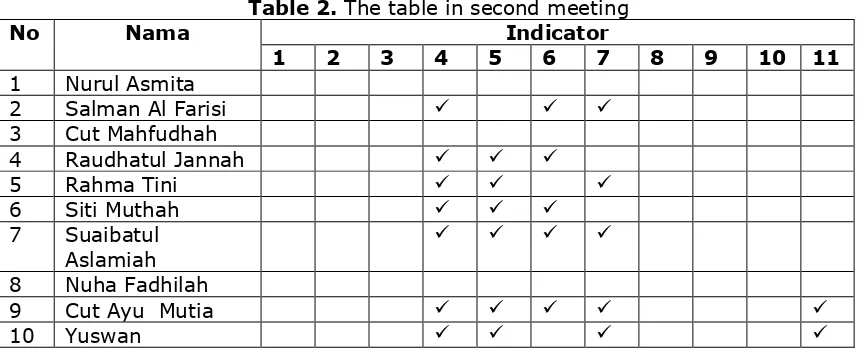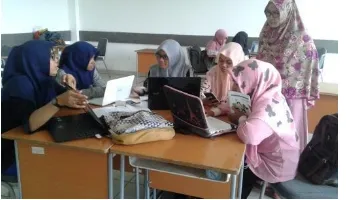729
Active Learning Process in
Bidik Misi’s
Students
of Mathematics Education in Syiah Kuala
University
*
Sry Rasyiidu Tebe, Rahmah Johar and Suhartati
Department of Mathematic Education, Faculty of Teacher Training and Education, University of Syiah Kuala, Banda Aceh 23111, Indonesia;
*
Corresponding author: sryrasyiidu.sr@gmail.com
Abstract
Students’ active learning is a process which is affected students’
comprehension and ability in term tasks and activities. Consequently, the aim of this study was to dispose the activity of bidik misi’s students of mathematics education in Syiah Kuala University. The population of this study were chosen based on GPA (Grade Point Average) all of bidik misi’s
students at mathematics’ education in Syiah Kuala University. The
sample was collected by purposive sampling. Purposive sampling was used because there was one class that has the highest number of bidik
misi’s students. Besides the students in the force of 2015 has been
following several courses so to see the activity that was analyzed based on GPA more efficiently done on that class. Accordingly, ten students were selected as sample. Data collection was obtained by observation and interview. The observation was used to identify student’s active learning in class. The interview which was employed to identify the causing of students active learning was done after the observation. In teaching learning process, there were several bidik misi's students is active, however there were several bidik misi's students is not active. it was caused some factors such as students’ motivation influence and
students’ environment influence.
Keywords: active learning process, learning outcomes, GPA.
Introduction
Learning Process is process built by practice and experience which do inside or outside class. Learning is basic process of development of human life. The important aspect of the learning process is activity. As stated in Stigler and Hiebert (2004),
students’ active learning greatly influences the success of learning. Student-centered
730 Based on the results of the study Jana, et al., (2011) was found only lecturer who presented teaching materials while the students simply recorded what was taught by the lecture this condition caused students to become passive. Practically, students don’t have ability ask question in the classroom during the during the learning process takes place. The lack of the abilities due to learning process in class cause by teachers deliver materials in one direction.
In line with Bowel, Eison, and McCallum (2013), conventional method was generally used by teachers in teaching. Yudistiro (2016) also stated that students who were learning were unable to choose a good way of learning. It caused the limitless of knowledge to ask question about the materials that was taught by the teachers and also caused students’ lack of confidence. Students look passive and silent throughout the learning process takes place, this is caused by the method used is
the professor’s lecture (Nurhasanah, 2012). This activity is not in line with
expectations as proposed (Momani, Asiri, & Alatawi, 2016) that the student is able to apply the learning to be better with active learning.
Tuition Fee Assistance Program namely bidik misi, is given to support students economic. Students’ which get the bidik misi is students who have concern in economy (Sucahyo, 2014). The students are required to further enhance the good achievements in the field of curricular, co-curricular and extracurricular activities. This has an impact on other students to further improve performance. Bidik misi’s aimed at delivering graduates who are independent, productive and social care, indefinitely contribute to reducing poverty (Kemritekdikti, 2015). There are many efforts being made to improve academic achievement learning among student (Abidin, et al., 2011). According to Tessema, Ready and Astani (2014) the value of the average satisfaction of the GPA of students who do not work tends to be higher than in students who work part-time.
Based on the introduction above the problem in this what is the relationship between bidik misi students’ active learning and their GPA? And what is the causing of that phenomenon?
Research Method
This research was conducted in order to find out the relation of student activation in activation of teaching and learning process based on student's math education GPA of Syiah Kuala University. The subject of this research is bidik misi students batch 2015 which consist of 10 students. Jigsaw, one of the cooperative learning is one of the cooperative learning that push the student actively and help one another on
comprehend the learning material to achieve/gain the maximum
performance/achievement (Isjoni, 2010). Jigsaw put the student into some small groups which consist 4 -6 students and each group get the information about the topic from their learning material (huda). In the observation class, the student is divided into source class and expert class to explain learning material that given for each group member.
731 problems. The indicator learning process by jigsaw was adopted from Harahap (2011). The subject in observation class used discussion method in teaching learning strategy subject. Whereas, the interview conducted after the researcher found the result of observation class. The interviewed student is the bidik misi's student who have the high level such as active, moderate, and low in class. The data analysis conducted based on the result of this observation in the form of the descriptive activity in teaching learning process for bidik misi's students.
Results and Discussion
Based on the results of data analysis are outlined that the level of activity bidik
misi’s student are divided into high, medium and low. The observations were made
with two meetings. At the first meeting, and learning activities carried out by discussions with the expert group so that some indicators did not show up. Here is presented the data at the observation first meeting.
Table 1. The table in first meeting
N
In the observation of the second meeting, all the students back to explain the field of knowledge that has been gained in the expert group to the original group. At this meeting all indicators were visible. The second meeting, there were some students who were not present, so many indicators that cannot be seen in these students. Here is presented the data at the observation second meeting.
Table 2. The table in secondmeeting
No Nama Indicator
732 and low can be seen from the result of table observation. Each indicator was observed by assessment in the form of a checkmark for students' activeness, while students who are not active only were emptied. Moreover, student centered was in teaching learning proses. This is supported by previous studies (Nurhasanah, 2012), that a constructivist approach is student-centered that expected in teaching learning process to be actively. That is the result of learning activities on the activity level classification of students is high, medium and low.
Figure 1. Discussions that occur in students a high level of activity.
Based on the figure above, it can be seen student’s high activity level; they are in a good teaching learning process. The student look actively in presenting the material, also they are actively in the question and answer process and respond the questions. Further the discussion that occurring of student medium level of activeness can be seen in the figure below.
Figure 2. Discussions that occur at a low activity level student.
Based on the figure above, it can be seen student’s high activity level; they are in a good teaching learning process. The students were active in teaching learning process, but students in the medium level of activeness lack of motivation to respond friends and professor’s questions.
Figure 3. Discussions that occur at a low activity level student.
733 research conducted after the data obtained on the observation that on May 18, 2017 and it was done by three students namely CAM, RJ and SM. The student is a student who has classified the level of activity in the classes was observed during the learning process in class with discussion method. In the process of interviewing students who were high-level classification is CAM. These students are actively involved in the teaching learning process both in presentation and question and answer. It is caused by several factors which can include the students who have the urge or high motivation, this student is also active in the discussion both ask, answer and comment. Furthermore, in the terms of the GPA student, CAM has good GPA, which corresponds to the level of activity in the learning process, namely 3.20. The results of this observation are supported by Momani, Asiri and Alatawi (2016) that an active student is able to apply the learning well.
The students who have the medium level activeness is RJ. as described in the picture above, students who have the medium level activeness also have the same potential as CAM. But RJ lacking motivation while responding answer a few lecture questions. It occurred because the students were shamed and fear wrong to respond the lecture question so that these students decided to silent and hesitant to answer the lecture question. Besides RJ has the ability to communicate in presenting some material well and able to explain in detail the materials provided. In addition, if the terms of the GPA student, the GPA of RJ in the teaching learning process, namely 3.00. This observation is supported by the results of Momani, Asiri and Alatawi (2016) that an active student is able to apply the learning well.
Meanwhile, a student with a low level of activity in this class was one person, who is SM. During the discussion SM is not active in the teaching learning process, SM only explain the material provided. However, during the process of answering-question is done SM just silent and look will not answer the question. After the interviews, it found that the cause of the student inactivity due to a lack of motivation in learning, have many activities outside the course, has a lot of tasks and less active discussion. The students' learning motivation is strongly influenced by the environment. Some of these factors are appropriate with the achievements gained or GPA obtained of 2.9. This is supported by previous studies that students who
734
References
Abidin, M. J. Z., Rezaee, A. A., Abdullah, H. N., & Singh, K. K. B. (2011). Learning styles and overall academic achievement in a specific educational system.
International Journal of Humanities and Social Science, 1(10), 143-152. Bell, D. K. J. (2006). Active Learning handbook. Missouri: Webster University.
Handhika, J. K. S. (2011). Improving students in learning through active participation presentation methods classroom. Education Journal, 3(1), 47-54.
Huda, M. (2011). Cooperative learning methods, mechanical, structural and applied model. Yogyakarta: Student Library.
Isjoni. 2010. Cooperative learning effectiveness study group. Bandung: Alfabeta. Jana, H., Erin, D. S., Kate L. B., Rachel, E. T., & Amy, M. G. (2011). Learning by
doing: An empirical study of active teaching techniques. Journal of Effective Teaching, 11(2), 40-54.
Kemritekdikti. 2015. Implementation Guidelines Help Bidikmisi Education Costs In 2015.
McCallum, D. (2013). Journal writing as an active learning tool in history education. Teaching Scholar Caribbean, 3(1), 23-39.
Momani, M., Asiri, M.A., & Alatawi, S. M. (2016). The impact of implementing active learning strategies in teaching English from the perspective of Tabuk Region Educational Intermediate School Teachers. Asian Journal of Educational Research, 4(1), 19-35.
Nurhasanah, F. (2012). The activeness students in the learning process planning and development course mathematics learning program through constructivist approaches in lesson study activity. Scientific Journal of Mathematical Study Program STKIP Siliwangi Bandung, 1(1), 62
Oberg, M. (2015). Active Learning Manifaseted Within a Synchronous Online
Classroom (doctoral dissertation). Retrieved from University of Pittsburgh ETD. (Accession No. 24623)
Sucahyo, A, Y., & Muhammad, H. N. (2014). Comparisons between the student academic achievement and student with scholarship and those without scholarship. Jurnal Pendidikan Olahraga dan Kesehatan, 2(1), 266-268.
Tessema, M, T., Ready, K. J., Astani, M. (2014). Does part-time job affect college students' satisfaction and academic performance (GPA)? The case of a mid-sized public university. International Journal of Business Administration, 5(2), 50-59. Yudistiro. (2016). Relations with the academic procrastination learning achievement
in student active in extracurricular activities. E-Journal Fisip Unmul Psychology,

